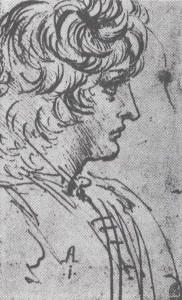It is important to understand just how widespread the registration or recording of financial transactions was in Italy during the 16th Century. When people bought and sold items, when people traveled, or when there was a succession, it was inevitably documented somewhere. Sadly a lot of these documents disappeared over time, never to be seen again. The ones that remain, however, many of which were newly discovered, can often tell us a great deal about what happened.
In 1518, one of Leonardo’s servants and pupils, Gian Giacomo Caprotti da Oreno, or Salai as he was better known, facilitated the sale of several paintings to King Francis I, attested by a Royal Receipt discovered only recently in the archives of the Milan National Library.
Salai was not only Leonardo’s apprentice, but he is widely believed to have been his companion and lover. In fact, it was Da Vinci who had given him the nickname ‘Salai’, meaning ‘Little Devil’. He accompanied Da Vinci to France in 1516, but had left his side at Cloux the year before the master’s death.
The royal receipt of 1518 is acknowledged by the Louvre as evidence that the ‘Mona Lisa’, the ‘St. Anne’ and the ‘St. John the Baptist’, which are now hanging in the museum, had been acquired by King Francis I, and entered the French Royal Collection during that year. The sale was facilitated by Salai, and the high value of the transaction has led many experts to confirm that these were the very same paintings that the Cardinal of Aragon saw in 1517, which Antonio de Beatis wrote about in his journal.
Following extensive research by Bertrand Jestaz, published in 1999, the Louvre Museum dates the acquisition of their ‘Mona Lisa’ to this event and date. This fits with Antonio de Beatis’s account of the painting he saw when visiting Leonardo at Cloux in 1517. Vincent Delieuvin, curator at the Louvre, confirms this in his 2017 book. Within a year of the sale, Leonardo had passed away. Leonardo’s last will and testament lists many items that does not include any paintings.
However, a document dating from 1525 and rediscovered only recently in 1992, lists an inventory of Salai’s assets after he died. It includes a painting listed as ‘La Honda’, which is thought to be ‘La Gioconda’. This painting was given such a high value in the inventory that many experts are convinced it was an original Leonardo da Vinci. In fact, a later corrected version of Salai’s will even lists the painting as “La Gioconda.” Most experts at the time were convinced this was referring to the Louvre painting. However, by 1525, Francis I was a prisoner of the Spanish and was most certainly not so concerned about the acquisition of paintings.
Both the receipt and the inventory could not be referring to the same painting of course as they referred to different transactions at different times. A simple explanation for the existence of these two documents is that Salai had handled two Mona Lisas, both painted by Leonardo. He would have handled the sale of the Louvre ‘Mona Lisa’ painting to King Francis I in 1518 and taken the other (the ‘Earlier Mona Lisa’) which remained with him and was listed in his estate in 1525. This, again, implies that there were two Mona Lisa paintings by Leonardo Da Vinci. There seems to be no other plausible explanation.
